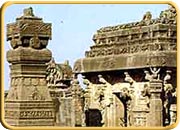Ellora
Ellora
Places of Interest in Ellora
 Unlike
the caves at Ajanta, the Ellora caves were never 'lost'. Largely because it
lay on a more frequented route, Ellora remained in the public eye. In fact,
Kailasa Temple remained a practising shrine until the 19th century. Several
travellers to India including the 10th century Arab geographer Al Masudi and
Niccolao. Manucci in early 17th century mention the caves in their accounts.
Unlike
the caves at Ajanta, the Ellora caves were never 'lost'. Largely because it
lay on a more frequented route, Ellora remained in the public eye. In fact,
Kailasa Temple remained a practising shrine until the 19th century. Several
travellers to India including the 10th century Arab geographer Al Masudi and
Niccolao. Manucci in early 17th century mention the caves in their accounts.
The Caves
There are 34 caves, of which 12 are Buddhist, 17 Hindu and 5 Jain. The caves all face west, so are best seen in the afternoon. The Buddhist caves are to your far right as you face the curve of the Charanadari Hill, then come the Hindu ones, and finally, the Jain cave temples to the far left.
Although not too far removed from the Ajanta caves in terms of both space and time, the chaityas and viharas of Ellora are architecturally and sculpturally different. Compared to the Ajanta paintings and sculptures, the Ellora representations are more earthly, drawing elements from the Vajrayana school of Buddhism which was permeated with primitive ideas of magic and mysticism. So, the dwarapalas that flank each doorway, the gigantic Boddhisattavas and their consorts have a robust earthiness about them
A masterpiece of Architectural
In fact, it is architectural skill rather than sculptural aesthetics that Ellora is noted for. Buddhist Cave 12 or Tin Tala, for instance, has a rather plain edifice with unadorned pillars and the sculptured panels are only on the inner walls. But its historical value lies in the fact that human hands fashioned a three- storeyed building from solid rock with such painstaking skill that even the floors and the ceiling are smooth and levelled.
Tin Tala cave is a commodious monastery- cum-chapel, with cells enough to house 40 monks. It dates to the Rashtrakuta period in the middle of the 8th century and, in fact, the third floor, which contains the most sculpted decoration, was being excavated even as the Hindus were carving the magnificent Kailasa Temple further along the rock face. The cruciform layout of the third storey in Cave 12 may also be the inspiration behind the Dumar Lena (Cave 29) and the Shiva cave at Elephanta.
Kailasa Temple Ellora:
The other Buddhist caves as well as the first few Hindu caves are fairly unremarkable and do not prepare you for the magnificence of Kailasa Temple or Cave 16. Believed to have been started by the Rashtrakuta king, Krishna I, Its excavation must rank as an architectural wonder.
more details
Select a holiday with us